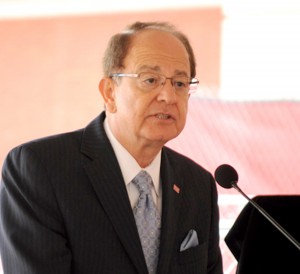USC on track to raise $6 billion by 2018
USC’s fundraising campaign has raised $3.7 billion to date, putting the university within reach of its $6 billion goal by the end of 2018.

Halfway there · President C.L. Max Nikias speaks at the launch of a fundraising initiative in November 2012. USC has raised $3.7 billion to date. – Daily Trojan file photo
The campaign was the largest of its kind when it was launched in 2011 and is now second only to Harvard’s $6.5 billion initiative. According to the Council for Aid to Education, the campaign’s success thus far made USC one of the top three fundraising universities in 2013, behind Stanford and Harvard.
“[The project is] a combination of having very compelling visions for a strategic plan and confidence in the strength and enthusiasm of the Trojan family to help the university,” Scott Mory, associate senior vice president and campaign director, said.
Alumni have played a significant role in fueling the university’s philanthropic effort. According to Mory, approximately $2.2 billion of the funds raised come directly from USC parents and alumni.
Patrick Auerbach, associate senior vice president for alumni relations, said this prolific giving stems from the long-term relationships the university maintains with its alumni.
“The process of donor cultivation and stewardship is lengthy,” he said. “These relationships with the donors for the most part have been going on for a long time.”
One of the largest gifts in USC history came from Dana and David Dornsife, who in 2011 donated $200 million to the university. Back in 1986, Auerbach recalled, the Dornsifes made their first contribution of just $100.
“Every donation counts,” Auerbach said. “We want alumni to feel a sense of ownership, responsibility and accountability for USC.”
Mory is optimistic that the university will stay on track for a 2018 completion of the $6 billion goal.
“We’re sticking to our campaign plan led by President Nikias and we have a wonderful team of development professionals and volunteers who help us reach out across the Trojan family,” he said.
The endowment is expected to be split evenly, allocating $3 billion for student scholarships and faculty research programs and the remaining $3 billion to capital projects, infrastructure and academic priorities.
One visible effect of the campaign is the construction of The Village, a $650 million campus expansion to be located in the space formerly occupied by the old University Village. Donations have also funded the McKay Center and the recently opened Wallis Annenberg Hall.
“Students are already starting to realize the benefits that come from the campaign’s success,” Mory said.
USC, the state’s largest private university as well as its most internationally diverse, has benefitted from such large-scale philanthropic efforts. Not all students agree, however, on how the university’s considerable financial resources should be utilized.
Deepa Ramakrishnan, a freshman majoring in business administration, expressed concern about the community surrounding the campus.
“USC’s $6 billion campaign comes at a time during which the situation in South Central L.A. is still poor, and one would hope that a portion of this gargantuan fund is going towards community outreach, as no amount of privilege can separate us from them,” she said.
The university expects the campaign to enhance students’ own academic lives and the lives of future students.
“One of the campaign’s goals is to support current academic programs and current scholarships,” Mory said.
Anubhav Sarkar, a freshman majoring in computer science, said the depth of the endowment benefits USC’s academic reputation.
“[The endowment] shows that USC is really taking the next step to distinguish itself as a top-tier academic institution, and that it will be home to a new generation of the best scholars,” he said.

